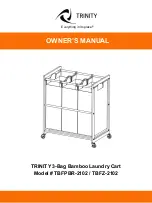
- 18 -
low
b. Low ambient temperature
c. Air probe fault
d. Temperature controller fault
b. Move to another location
c. Change a new one
d. Change a new one
13.Evaporator
freezing up
a. Evaporator air flow restriction
b. Low temperature setting
c. Low ambient temperature
d. Defective controller or probe
e. Not stopping due to air leak, high
ambient temperature, condenser
air flow restriction or pull-down
cooling
f. Initially working then stopping,
moisture in the system
g. Refrigerant low or leaking
h. Capillary tube or expansion valve
blockage
a. Check for fans and air flow
b. Check for set-point
c. Change defrost cycle
d. Check for controller and probe
e.
Check for seal, door opening,
ambient temperature and condenser
air flow
f. Call
service
g. Call service
h. Call service
14.Water leak
a. Air leak in the wine cellar causing
excessive condensate
b. High humidity causing excessive
condensate
c. Evaporator air flow restriction
d. Water passages restricted
e. Drip tray leak (No water overflow
but water leak)
a. Check for air leak
b. Use drain line
c. Check supply air flow or air TD
d. Clean the drip tray
e. Seal the leak using silicone sealant
15.Excessive
condensate
in wine
cellar
a. Air leak in the wine cellar causing
excessive condensate
b. High humidity causing excessive
condensate
c. Water passages restricted
a. Check for any air leak
b. Use drain line
c. Clean the drip tray
16.Condensate
inside ducts
a. Drain line restricted
b. Continually running not stopping
c. Too cold supply air
a. Check for drain
b.
raise temperature setting or
increase defrost cycle
c.
Increase air flow or raise
temperature setting
17.Condensate
outside
ducts
a. Duct not insulated
b. High humidity
c. Too cold supply air
a. Check for insulation
b. Use
dehumidifier
c.
Increase air flow or raise
temperature setting
18.Circuit
tripping
a. Incorrect fuse or breaker
b. Incorrect
wirings
c. Failed
components
a. Check for proper fuse or breaker
b. Check for wirings and connections
c. Call
service
19.Noisy
operation
a. Mounting area not firm
b. Loose
parts
c. Compressor overloaded due to
high ambient temperatures or
airflow restriction
d. Defective
components
a. Add support to improve installation
b.
Check fan blades, bearings,
washers, tubing contact and loose
screws.
c. Check for airflow
d. Call service for checking internal
loose, inadequate lubrication and
incorrect wirings






































